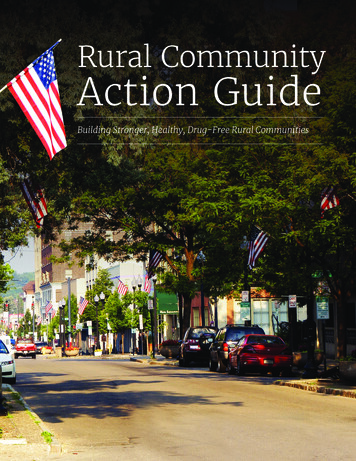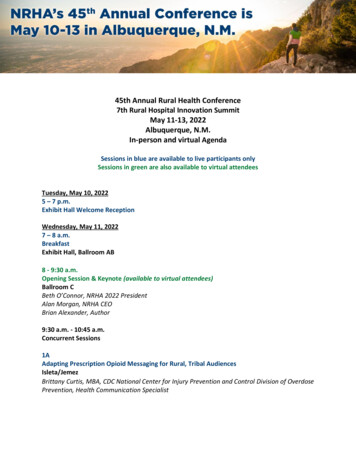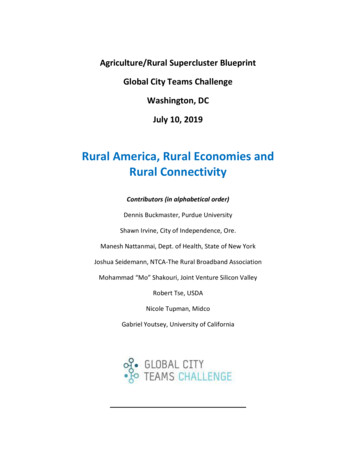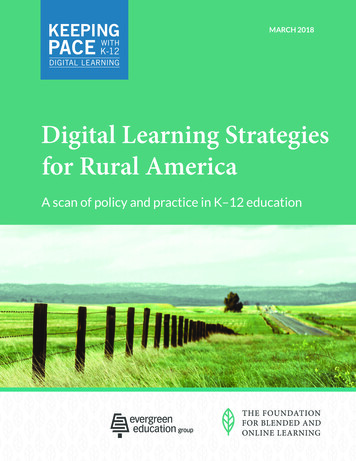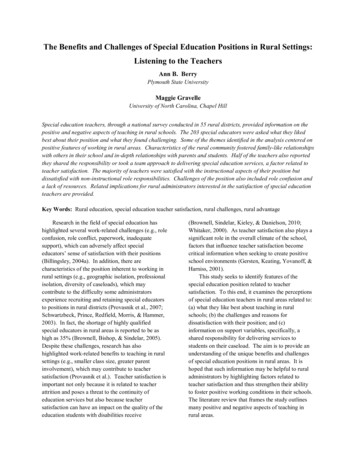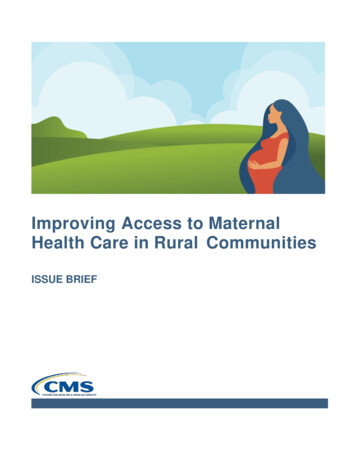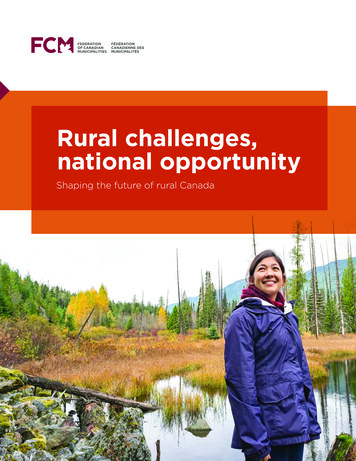
Transcription
Rural challenges,national opportunityShaping the future of rural Canada
CONTENTSIntroduction2FCM: The national voice of rural Canada3Rural leadership is shaping Canada3The state of rural Canada4Rural Canada is diverse5Rural Canada drives national prosperity5Rural Canada is changing6Rural Canada is raising capacity through partnerships9Shaping the future of rural Canada10Investing in the foundations of rural communities11Building next-generation telecommunications infrastructure13A housing strategy for rural communities15Connecting rural Canada to global markets17Federal-municipal partnership on trade promotion18Adapting to a changing climate19Promoting safer communities20Demonstrating proactive leadership22Community-building is nation-building24AcknowledgementsThis guide was made possible thanks to the leadership of FCM’s Rural Forum. FCM also acknowledgesthe expertise and professionalism provided by the Rural Development Institute at Brandon University,who spearheaded the analysis of economic and demographic trends in Statistics Canada’s data. We alsowant to thank members of the Canadian Rural Revitalization Foundation for offering their time to reviewthis report and enhance our recommendations. Finally, FCM thanks its rural members from across thecountry who shared their stories and the innovative solutions we can achieve when we work together.
IntroductionRural communities are essential to Canada’s prosperityand to the Canadian experience.People are drawn to the vast landscapes, small-town friendliness andquieter way of life that small communities can offer. And in the age ofonline connectivity, rural Canada is becoming more desirable for businessinvestment. The combination of affordable land and improved broadbandaccess means people can work from anywhere—and increasingly they arechoosing rural communities.Still, with limited fiscal capacity, ruralgovernments face formidable challengesproviding the infrastructure that’s neededto build the communities of the future.Municipalities shoulder 60 per cent of Canada’spublic infrastructure, with access to justeight–10 cents of each tax dollar. This fuels afiscal squeeze that peaks in rural communitieswith lower ratepayer densities and continuingyouth out-migration.Local governments have a strong trackrecord of delivering remarkable, innovativeand cost-effective solutions to local needs.What they do not have is flexibility to dealwith financial and administrative bottleneckswhen building better roads, wastewatertreatment and other local infrastructure2projects. Predictable funding allocations,fair-cost sharing, flexible fund stacking rules, andstreamlined administrative requirements are keysto getting projects moving in rural Canada.With the right tools, rural governments areready to build more livable and prosperouscommunities that can attract the talent theyneed to thrive well into the future. With smartdecisions from the federal government, wecan kick-start renewed growth and quality-oflife improvements in rural and remotecommunities across the country.
RURAL CHALLENGES, NATIONAL OPPORTUNITYFCM: The national voiceof rural CanadaFCM has been the national voice of municipalgovernment since 1901. With nearly 2,000member municipalities, we represent theinterests of local governments on policyand program matters that fall within federaljurisdiction. FCM members include Canada’slargest cities, small urban and ruralcommunities, and 18 provincial andterritorial municipal associations.FCM’s Rural Forum was established in2001 with a mandate to advocate for ruralcommunities and provide local governmentsin rural areas with greater access to FCM.The Rural Forum is made up of FCM membermunicipalities that are located in rural regions,along with urban communities with rural areasor significant rural interests.The Rural Forum meets quarterly to identifyand discuss issues of national significance forrural Canada, including rural infrastructure,rural economic development and broadbandconnectivity. Strengthened by the Forum’sinsight and leadership, FCM has in recent yearssecured unprecedented federal investmentand influence for rural communities.Rural leadership isshaping CanadaRural communities play a crucial role in nationbuilding. Throughout this report, we profile ruralcommunities that are showing leadership inshaping Canada’s future. These communitieshave remained resilient, adapting to familiarchallenges facing their communities—includingaging populations, the closure of a majorlocal employer, or limited access to thecommunications infrastructure that we allneed to remain competitive.membership, which includes towns, villages,counties and regional municipalities of varioussizes from coast to coast to coast. Alongthe way, they partnered with stakeholders,neighbouring communities and other ordersof government to turn their visions into reality.That’s why FCM continues to work with thefederal government to champion rural issues.In this report, we offer recommendations forthe federal government on how to support andgrow rural Canada. We are working to ensurethat federal policies and programs reflectrural priorities, so that we can scale-up localsolutions and build more sustainable ruralcommunities like those profiled in this report.These communities are putting forwardinnovative projects to tackle these challengesand continue to succeed in the 21st century.They represent the diversity of FCM’s ruralfcm.ca3
The state ofrural Canada4
RURAL CHALLENGES, NATIONAL OPPORTUNITYRural Canada is diverseAccording to the 2016 Census, 90 per cent ofCanada’s municipalities are located outsidecensus metropolitan areas (CMAs), and they arehome to just over 10 million Canadians—almostone-third of the country’s population1. However,rural realities vary across the country.Rural Canada is extremely diverse in termsof population size, density and degree ofremoteness or proximity to urban centres.For example, a rural township of 11,000 in theGreater Toronto Area and a large municipaldistrict of 13,000 in northern Albertaexperience very different lifestyles,opportunities and challenges. Therefore,narrow definitions or a “one-size-fits-all”approach to rural policy will not work.Solutions to rural problems must reflectrural Canada’s diversity.Rural Canada is growing overall, but at aslower pace than Canada’s CMAs. From 2001to 2016, Canada’s non-metro2 population grewby 5.5 per cent, while Canada’s overall growthrate was 16.9 per cent3. However, it’s clear thatrural Canada is not growing everywhere. RuralCanada is growing near cities, in cottagecountry and other desirable retirementlocations, in northern areas with higherIndigenous birth rates, and in a few areaswith resource development on the rise.Rural Canada drivesnational prosperityRural communities make significantcontributions to Canada’s economic growth,employing over four million Canadians andgenerating 27 per cent of national GDP.5 Ruralareas supply food, water and energy forrapidly growing urban centres and sustainindustries that contribute to Canada’seconomic prosperity. Rural communities alsoprovide important recreational opportunitiesfor urban Canadians and international visitors.Rural GDP growth by province or territoryShare of GDP innon-metro areaNon-metro GDPgrowth 2011/16Canada27.1%1.2%Newfoundland and Labrador52.6%-6.5%Prince Edward Island100%7.4%Nova Scotia46.2%-3.0%New 9%-4.5%British Columbia28.9%10.5%Yukon100%7.1%Northwest Territories100%9.4%Nunavut100%11.8%(Statistics Canada, 2013, Statistics Canada, 2017)We also know that Canada continues to rapidlyurbanize. In fact, 13 of the top 25 fastest-growingcommunities outside CMAs were peripheralmunicipalities located within Statistics Canada’scensus agglomerations (CAs)4. These are areasthat consist of neighbouring municipalitiessituated around a core of at least 10,000 people.1Rural Canada continues to create jobs acrossdifferent sectors of the economy, with jobgrowth of over seven per cent over fifteen yearsfrom 2001 to 2016. In 2016, almost 23 per centof Canadians worked in rural communities. Muchof this job growth was driven by the health careand social services (37.4%) that support changingrural communities, construction (62%), andStatistics Canada, 20172 In this report, metro Canada is defined as the area categorized as a Census Metropolitan Area (CMA) in the Statistical Area Classification (SAC) of Statistics Canada. Acensus metropolitan area (CMA) is formed by one or more adjacent municipalities centred on a population centre or core. A CMA must have a total population of at least100,000 of which 50,000 or more must live in the core. Meanwhile, non-metro Canada is defined as areas that are not categorized as a CMA in Statistics Canada’s SAC.3 Statistics Canada, 20174 Statistics Canada, 20175 Note that the 2016 GDP of CMAs was not accessible at the time of publication. The latest CMA GDPs released by Statistics Canada are from 2013. Therefore, we usedthe number of employed people of a given economic sector in CMAs and in non-metro areas to weight the share of GDP that comes from the non-metro areas ofa given province or territory, following Bollman and Ashton (2014).fcm.ca5
professional, scientific and technical services(47.5%), mirroring the broad economic anddemographic shifts experienced in Canadiancommunities of all sizes.Rural employment in 2016Profile in municipal innovation:Baie-Saint-Paul, QuebecIn May 2005, the Town of Baie-Saint-Paul becamethe first municipality in Quebec to adopt LocalAgenda 21, a sustainable development strategyfor the 21st century that responds to local issuesand recognizes the value of the community’scultural heritage. The plan incorporated theperspectives of community members, particularlyyoung people, and the sustainable developmentprinciples adopted by 172 nations in the 1992Rio Declaration.SectorNumberemployedTotal employed, all industries, all Canada18,079,900Total employed, all industries, non-metro4,113,000Services-producing sector, non-metro2,754,000Goods-producing sector, non-metro1,359,000Wholesale and retail trade639,400Health care and social 06,200Accommodation and food services282,200Educational services245,500Agriculture234,300Transportation and warehousing214,200Forestry, fishing, mining, quarrying, oil and gas204,300Other services (except public administration)197,400(Statistics Canada, 2017)The plan is based on four fundamental concepts:economic development, environmentalprotection, social equity, and cultural vitality.Baie-Saint-Paul’s cultural policy and LocalAgenda 21 have prioritized the inclusion of culturein land-use planning to develop a communitythat complements and respects its culturaland natural heritage. The Town is collaboratingwith local agricultural producers in implementingpolicies to preserve the Gouffre River basinand with the MRC de Charlevoix to preservethe region’s natural environment.This land initiative, support for cultural vitalityin public spaces, and a policy promoting publicarts have resulted in lively, attractive streets andspaces that have a strong identity. Ultimately,the Local Agenda 21 cultural policy has madeculture an essential part of sustainabledevelopment and improved the appeal of thearea for tourists, businesses and new residents.Rural Canada is changingRural municipalities are on the front lines of thedemographic changes that have accompaniedour increasingly urbanized and knowledge-basedeconomy. For example, rural communities areattracting a growing number of retired Canadianswho need access to a range of goods and services,such as preventative health and social servicesand seniors’ housing. While the populationof seniors aged 55 and older is increasing inboth metropolitan and rural regions, smallercommunities will have fewer resources to help.Youth retention is also critical to ensuring thelong-term economic vitality of rural Canada.However, limited services in rural communitiesand greater access to learning and employmentopportunities in cities have drawn young peopleto Canada’s metropolitan areas. In fact, thepopulation of youth aged 15 to 19 in rural Canadadeclined by 10 per cent between 2011 and 20166.6 Statistics Canada, 20176
RURAL CHALLENGES, NATIONAL OPPORTUNITYWhen young people finish training at Canada’scolleges and universities, they are less likelyto seek employment opportunities in ruralcommunities, where the population of youthaged 24 to 29 has grown just three per centbetween 2011 and 20167. Attracting moreyoung and talented workers will be essentialto ensure rural Canada continues to thrive.Youth growth rates in urban and rural Canada3.00%2.00%1.00%Profile in municipal innovation:Rural 292015/16Metro25–29(Statistics Canada, 2017)As rural populations continue to age, thesetrends show that rural Canada’s workforcehas decreased. Between 2001 and 2016, thenumber of potential workers has continuouslydecreased from 1,475,220 to 1,131,830 (-23.3%)—whereas the number of potential retirees hascontinuously increased from 1,015,940 to1,701,540 ( 40.3%). In 2001, there wereapproximately 1.5 potential labour marketentrants for each potential retiree innon-metro Canada. By 2016, there wereapproximately 0.7 potential labour marketentrants for each potential retiree8.At 5,500 km2, Halifax, Nova Scotia, is Canada’slargest municipality geographically—andhas the largest rural share of totalpopulation (19.8%) among cities with apopulation above 250,000. However, itsurban and rural communities often face verydifferent challenges and opportunities.To promote innovative solutions to thesechallenges and capitalize on opportunities,the annual Halifax Index now includes a“Rural Halifax Profile,” providing a tailoredanalysis of changing economic conditions.The Halifax Index is a definitive look at thecity’s story—the strength of its economy,the health of the community, and thesustainability of the environment. Itprovides insights for actions that willstrengthen and grow the city.The Index also serves as the city’s reportcard on progress toward the goals set outin the Halifax Economic Growth Plan. Itrecognizes the intrinsic value of therural-urban lifestyle in Halifax that fewother big cities in Canada can offer.7 Statistics Canada, 20178 Statistics Canada, 2017fcm.ca7
Working age population in non-metro 0.0%80.0%60.0%40.0%20.0%0.0%2001Profile in municipal innovation:Municipal Asset ManagementProgramAging infrastructure, competing prioritiesand limited budgets. These are some ofthe challenges municipalities face inmaking infrastructure decisions today.FCM’s Municipal Asset ManagementProgram (MAMP) is a five-year, 50-millionprogram designed to help Canadianmunicipalities make evidence-basedinfrastructure investment decisions thatmake infrastructure dollars go further.Through flexible grant funding,communities can take on the assetmanagement projects that matter mostto them. The Town of Churchbridge,Saskatchewan, is using MAMP fundingto better understand what it needs todo to maintain municipal buildings, roads,water and wastewater assets over thelong term. A group of neighbouringmunicipalities, including two RuralMunicipalities and three Towns, isworking with MAMP to develop acommon language and metrics that willhelp them plan for infrastructureinvestments that strengthen the regioninto the future.82006Potential labour marketentrants (10–19)20112016Potential retirees(55–64)(Statistics Canada, 2017)Rural municipal leaders are working hard toaddress this demographic shift. They recognizethat strategies to promote economicdevelopment require new approaches toattract people to rural communities. To securethe talent and skills needed to generate localeconomic growth, these communities mustattract and retain new residents, includingyoung people, immigrants and Indigenouspeople. Retention requires having the rightsupports in place. For example, immigrantswho find themselves unemployed orunderemployed often turn to localgovernments for help, and whether theyremain in the community depends onwhether they find appropriate supports.Municipalities are also working with otherorders of government to attract and integratenewcomers by providing essential communityservices. These include libraries, public transit,child care, recreational facilities and, in somejurisdictions, affordable housing.
RURAL CHALLENGES, NATIONAL OPPORTUNITYRural Canada is raising capacitythrough partnershipsThe most significant challenge facing manyrural communities is limited financial andhuman resources. FCM research found thatroughly 60 per cent of Canadian municipalitieshave five staff members or less. This lack ofcapacity is one reason why programs thatsucceed in urban communities do notnecessarily work in rural communities. Animportant solution is to share tools andresources through partnerships with federaland provincial/territorial governments,Indigenous neighbours and other municipalitiesof all sizes. Programs must build on communitypriorities and offer flexibilityIf urban centres are Canada’s engines ofgrowth, rural communities fuel these engines.Strong rural communities deliver significantadvantages to Canada’s rapidly growing urbancentres, and rural leaders are partnering withtheir urban counterparts to drive regionaleconomic development. We need to betterunderstand the interdependencies betweenurban and rural Canada and how the healthand success of one affects the other. Federalpolicies and programs must also adapt to thedifferent realities in rural and urban areas andhelp facilitate regional partnerships.Rural municipalities are also partnering with theirIndigenous neighbours to better deliver essentialservices and advance reconciliation efforts.Municipal elected officials across rural Canadaare increasingly speaking about the need formunicipalities to support reconciliation withIndigenous peoples and governments toaddress complex socio-economic issues, oftenrooted in Canada’s history of colonialism andthe residential school legacy.Positive relations between municipalgovernments and Indigenous governmentsrely on pragmatic cooperation, includingservice-delivery agreements, joint meetingsand Indigenous representation on relevantboards and agencies. Municipalities may alsoProfile in municipal innovation:Winkler, ManitobaWinkler, Manitoba, is a 90-minute drivesouthwest of Winnipeg. The communityhas grown by three to four per cent peryear over the past 12 years, evolving intothe industrial and commercial centre forsouthern Manitoba. To help attract andretain residents, the municipality hasplayed an active role in purchasing landfor industrial development, providingbusiness incubation space and increasingthe stock of affordable housing.Municipal leaders also work with localbusinesses and an immigration consultingcompany to aggressively recruit skilledworkers from abroad and support theirapplications to the Manitoba ProvincialNominee Program. As a result, Winklerhas welcomed new residents originatingfrom 88 different countries and 29 percent of residents in the most recentCensus were foreign-born.pair with neighbouring Indigenouscommunities to jointly pursue social andeconomic development opportunities.FCM’s award-winning Community InfrastructurePartnership Program (CIPP) and CommunityEconomic Development Initiative (CEDI) areforging stronger and more productiverelationships between municipal and Indigenousneighbours. These partnerships help reducecosts of providing services, enhance socialand economic development, and buildcapacity within both Indigenous andmunicipal governments.fcm.ca9
Shaping the futureof rural Canada10
RURAL CHALLENGES, NATIONAL OPPORTUNITYThe first half of this report reveals that ruralcommunities are essential to Canada’s prosperity,generating 27 per cent of national GDP—andsignificantly more in some provinces. But withlimited fiscal capacity, rural governments faceformidable challenges in providing the infra struc ture and services communities need togrow and thrive.Rural communities are forging partnerships withkey stakeholders. Through FCM, they are alsourging federal leadership to develop newprograms and strategies to tackle rural challenges,recognizing these communities’ unique needs.Investing in the foundationsof rural communitiesMunicipalities own nearly two-thirds of the coreinfrastructure assets—roads, bridges, waterand wastewater facilities—that are critical toCanadians’ quality of life and our country’scompetitiveness. Yet many rural municipalitieswith limited tax bases and capacity struggleto meet their infrastructure needs.FCM’s advocacy has driven major successeson behalf of rural communities, including anunprecedented 11-year infrastructure plan.The 2 billion, 11-year Rural and NorthernCommunities Fund will support better roads andbridges, clean water, wastewater treatmentand a full range of rural transportation needs.In February 2018, the government announcedan increase to its cost-share under the ruralfund, stating it will fund up to 60 per cent ofeligible infrastructure costs in communitiesunder 5,000 people. Larger rural and northerncommunities will continue to receive fundingfor up to 50 per cent of eligible costs, or up to75 per cent for projects in the three territories.A rural lens would recognize rural Canada’sdiversity by ensuring that eligibility criteriafor all infrastructure programs consider thebreadth of priority projects in rural communities.It would serve less populated, more remote ormore fiscally constrained municipalities. And itwould incorporate project categories that wouldbe eligible under the new fund for rural andnorthern infrastructure.Streamlining the administration of infrastructureprojects would help rural communities accessfunds efficiently and fairly. It would helpmunicipalities leverage regional partnershipsby providing the flexibility and support for ruralmunicipalities to bundle regional projects andachieve economies of scale.OUR RECOMMENDATIONS:Apply a “rural lens” to eligibility criteriafor all federal infrastructure programs toempower smaller communities to directlyfund pressing local needs.Design future rural infrastructure programsto provide long-term predictable fundingto support the capital priorities of localgovernments, with flexibility for eligibilitythresholds to be negotiated betweenprovinces/territories and their respectivemunicipal associations.Continue federal engagement with FCMthroughout the rollout of the Investingin Canada plan to ensure that ruralcommunities have access to the righttools to transform their communities.This is one example of how applying a “rurallens” to infrastructure program design andpolicy could make a big difference for smalland remote communities. Getting this rightwould enhance rural economic developmentand community resiliency.fcm.ca11
FCM’s rural advocacy: a success storyFCM’s strong advocacy has led to thebiggest investment in rural infrastructurein a generation, including through the11-year Investing in Canada infrastructureplan. The 2015 federal election strategyexecuted by FCM solidified the narrativethat local governments are central tothe success of our economy andcountry—and solidified FCM as ourunited national voice.Post-election, FCM’s Rural Forumremained focused on further developingand communicating rural communitypriorities through the Action Plan for aStrong Rural Canada. Our members—municipal leaders—met repeatedly with12MPs, made submissions and spoketo parliamentary committees. FCMforged deep relationships with federaldecision-makers at every level, ensuringthat our rural voice is strong in Ottawaand in every riding across Canada.Turning the federal government’srural commitments into outcomeswill require ongoing engagement withlocal governments, to leverage theirlocal expertise and experience. Now isthe chance for FCM’s rural members toensure that the federal government getsit right and structures infrastructureinvestments in a way that empowersrural communities.
RURAL CHALLENGES, NATIONAL OPPORTUNITYBuilding next-generationtelecommunications infrastructureHigh-speed internet access is crucial todoing business and running local publicservices. In rural Alberta, municipalities saythat local physicians have difficulty accessinghealth records and electronic data due tounreliable broadband at hospitals, clinicsand patients’ homes.As one rural physician explained: “Unfortunately,there have been many situations where patientcare could have been significantly improvedif faster upload and download speeds wereavailable. As a physician in a remote location,I rely on the ability to communicate withspecialists, patient data, and evidence-basedmedicine data to provide comprehensive carefor my patients.”Through FCM’s engagement in CRTCproceedings and with Innovation, Scienceand Economic Development Canada, ruralmunicipalities in Alberta and across Canadabrought national attention to this critical issue.As a direct result of FCM’s advocacy, thefederal government recognized the importanceof federal investments to improve broadbandcoverage and capacity for rural communities.Since 2009, rural municipal leaders from acrossCanada helped secure over 1 billion in federalbroadband funding and played a critical rolein persuading the CRTC in 2016 to declareuniversal access to high-speed internet anessential service.This laid the groundwork for improved accessto high-speed broadband across rural andnorthern Canada. Moving forward, it will becritical for the federal government to developlong-term funding mechanisms to continuouslyimprove broadband coverage and capacity inCanada’s rural and remote communities.OUR RECOMMENDATIONS:Commit long-term predictable federalfunding to expanding broadband internetaccess in rural, northern and remotecommunities, and consult with localgovernments in developing fundingprograms and strategies.Consider affordability when developingbroadband infrastructure, to ensureaccess for all Canadians, whether theylive in large cities or rural, northern andremote communities.fcm.ca13
Town of FaroProfile in municipal innovation: Faro, YukonSince the abrupt 1997 closure ofCanada’s largest lead-zinc mine,vacant company housing in Farohas been an ongoing safety problemand eyesore. Nearly 20 years later,37 properties comprising 170 dwellingunits remained abandoned—ownedby a bankrupt corporation that oncemanaged housing for mine workersand owed the town 3 million inback taxes.In January 2016, Faro’s mayor andcouncil decided that dealing withthe vacant housing would be theirtop strategic priority. Staff devisedstrategies and brought forwardbylaws to take ownership of theproperties through the tax arrearsprocess. By the end of the year, thetown had secured possession of allof the properties.Most of the buildings are in a poorstate of repair, and about halfmay ultimately be torn down.In cooperation with the Yukon14government, a communitydevelopment team exploredways to fund hazardous materialsassessments, renovation and energyretrofits. The town put the propertiesup for sale in July 2017. Twelve of theproperties, comprising 36 dwellings,were sold by the end of the year foran average price of approximately 4,000 per unit.Sales agreements include propertytax rebates and incentives to ensurethat new homeowners renovate thehouses within three years. Buyersforesee a burgeoning rental housingmarket due to significant mineremediation work that will bringjobs to Faro in 2019. New subdivisionand zoning bylaws will also enableselling off single units of somemulti-dwelling buildings. But withno prospect of selling all 170 units,the town is pressing the federalgovernment to fund demolitionand cleanup costs as part of theirmine remediation obligations.
RURAL CHALLENGES, NATIONAL OPPORTUNITYA housing strategy forrural communitiesWhile Canada’s housing crisis is commonlyassociated with our largest cities, ruralcommunities across the country are alsofacing distinct and pressing needs. In fact,Statistics Canada’s 2014 General Social Surveyfound that adults in rural Ontario were morelikely to report experiencing homelessness orhidden homelessness than urban residents.The launch of a 10-year, 40 billion NationalHousing Strategy (NHS) in November 2017will help address this growing challenge andre-establish federal leadership on housing.FCM pressed hard for this breakthrough, andfour central NHS components reflect FCM’srecommendations: social housing repairs;replacement of expiring rent subsidies forexisting social housing; construction of newaffordable housing; and a portable housingbenefit. All four components will positivelyimpact rural communities.Profile in municipal innovation:Eastern Ontario Regional NetworkLaunched in 2010, the Eastern OntarioRegional Network (EORN) seeks to meetthe urgent need of rural communities foreffective, faster internet. This 175 millionproject, involving all orders of governmentas well as the private sector, waschampioned by the Eastern OntarioWardens’ Caucus. EORN now offersaccess to high-speed internet servicesto at least 95 per cent of homes andbusinesses in Eastern Ontario—a5,500 km span with 160 access points.The NHS offers significant funding to supportexisting social housing—both the buildings andthe low-income households who live there—inboth large cities and smaller communities. Themaintenance of aging social housing has beenchronically underfunded, so the commitmentto repairs will see closed units re-open, and thoseat risk of closing continue to serve low-incomehouseholds, with essential repairs undertaken.Preserving social housing is particularlyimportant in small communities, which are le
The state of rural Canada 4 Rural Canada is diverse 5 Rural Canada drives national prosperity 5 . country who shared their stories and the innovative solutions we can achieve when we work together. 2 Introduction . and social services (37.4%) that support changing rural communities, construction (62%), and .
